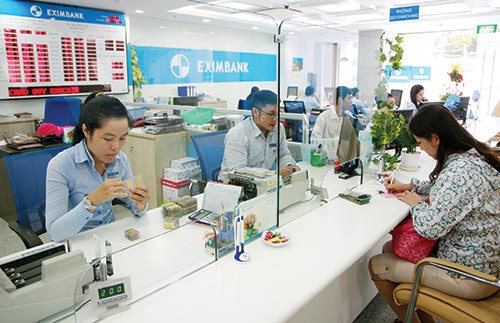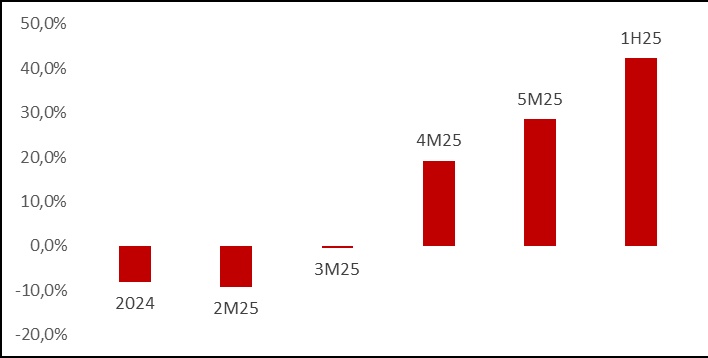Bad debts set to surge as year draws to a close

New, more realistic debt classification criteria have forced banks to set aside greater funds for risk provisioning Photo: Le Toan
According to Nguyen Kim Xuyen, DongA Bank’s deputy general director, bad debts made up 6.8 per cent of the bank’s total outstanding loans at the end of this October against a rate of 4 per cent at the end of last year.
The bank executive attributed rising bad debts to a domestic economy that is still largely struggling, making it hard to recover outstanding loans.
The application of new regulations on debt classification has resulted in rising bad debt volumes across the whole banking sector.
Eximbank also saw its bad debts sharply increase while the banking sector struggled to boost lending.
Eximbank’s credit actually contracted nearly 4 per cent in the first nine months of this year, while its bad debts amounted to VND2.68 trillion ($128 million), up 62.8 per cent against the end of 2013.
Bad debts account for 3.35 per cent of the bank’s total outstanding loans against 1.98 per cent rate early in the year.
In the case of ABBank, credit growth actually contracted 1.4 per cent by the end of the third quarter, meanwhile overdue debts reached VND3.73 trillion ($178 million), representing 16 per cent of total outstanding loans compared to 14.2 per cent at the end of last year.
PG Bank saw its bad debts inch up from 2.92 per cent to 3.06 per cent in January-September period.
In case of state giant BIDV, by end of the third quarter, bad debts reached VND7.96 trillion ($379 million), equal to 1.93 per cent of its total outstanding loans. Bad debts rose 7.3 per cent against the end of 2013.
At the Military Bank, bad debts jumped 31.6 per cent during the period to VND2.82 trillion ($134.5 million), making up 3.09 per cent of the bank’s total outstanding loans.
At Vietcombank, by the end of September bad debts represented 2.54 per cent of its total outstanding loans. However, Group 5 debts, which pose a real risk of default, accounted for nearly half of the bank’s bad debts, and rose approximately 70 per cent against the end of 2013.
Many bank executives say bad debts are emanating from not only old loans but also new credit contracts. However, debt classification requirements introduced by the State Bank of Vietnam’s (SBV) Circular 09, which came into effext from March 20 this year, have piled added pressure on banks in terms of risk provisions.
In this context, selling distressed assets remains a tough nut to crack for banks, since 75 per cent of their collateral is tied up in the real estate market, which is still relatively weak.
“Bad debts may even increase more sharply in the coming months after banks fully apply stringent requirements on debt classification and risk provisions,” said the director of a Ho Chi Minh City based bank, who also wanted the SBV to consider reducing the risk provision rate on special bonds provided by state-owned bad debt buyer Vietnam Asset Management Company (VAMC).
Tran Du Lich, a member of the National Financial and Monetary Advisory Council, said “For the banking sector to reach its full-year credit growth target of 12-14 per cent this year, the economy would need to absorb an additional VND100 trillion ($4.7 billion) before the end of the year. This is far too large an amount given the currently modest demand for capital.”
What the stars mean:
★ Poor ★ ★ Promising ★★★ Good ★★★★ Very good ★★★★★ Exceptional
Latest News
More News
- Vietnam works towards stock market upgrade in September (July 03, 2025 | 14:26)
- Gold monopoly policy retooling in the works (July 02, 2025 | 16:00)
- Vietnam eyes rate cuts amid ample liquidity and FX pressure (July 02, 2025 | 13:17)
- Stock market buoyed by upbeat earnings forecasts (July 02, 2025 | 13:08)
- Tax policies and market clean-up boost retail stocks (July 02, 2025 | 13:00)
- Proposed end to gold market monopoly to pave way for new players (July 02, 2025 | 12:56)
- Interest rates on downward trajectory (July 02, 2025 | 11:01)
- Vietnam banking on a digitally inclusive future (July 02, 2025 | 08:00)
- ASEAN considers strategies to soften non-tariff hurdles (June 30, 2025 | 11:21)
- ACCA revamps training for digital and sustainable era (June 26, 2025 | 19:21)


















 Mobile Version
Mobile Version